The security-related arguments for pursuing closer economic ties with Taiwan through a free trade agreement (FTA) are strong and widely cited. In 2019, a bipartisan group of 161 Members of Congress expressed this case in a letter to Ambassador Robert Lighthizer by writing, “Taiwan is a longstanding ally and a like-minded partner in the Indo-Pacific region that upholds and shares our values.”REF Similarly, experts at the Council on Foreign Relations wrote in June 2021 that “Taiwan’s continued security is critical to regional stability in the Asia-Pacific. As China’s military strength and confidence increase, the United States needs to find additional ways to continue to deter Chinese adventurism” and that an FTA with Taiwan “would also send a strong signal to China on the importance the United States places in its relationship with Taiwan.”REF The Heritage Foundation has also advocated extensively over the years for an FTA with Taiwan.REF
While U.S. security interests play an important role in trade policy, the economic case for deepening the bilateral relationship is just as strong. The last major analysis of the potential economic effects of a trade agreement between the United States and Taiwan was conducted in 2002 by the U.S. International Trade Commission (ITC) at the request of Congress. The ITC’s report estimated that “the removal of quantifiable barriers would have a negligible impact on U.S. production and gross domestic product (GDP), but would have a small impact on Taiwan production and GDP. Taiwan GDP could increase by 0.3 percent.”REF This report, while offering helpful data, is now quite outdated as nearly 20 years have passed. The trade relationship between the United States and Taiwan has experienced significant change and growth over that period.
Recognizing the need for updated data, this report includes a new economic analysis of a potential FTA. The study uses the same type of computable general equilibrium (CGE) model the ITC used to analyze the impact of removing tariff barriers between the two countries. However, the analysis goes one step further by modeling the potential effects of removing some non-tariff barriers in both countries. This added feature allows for a broader look at the impact of a trade agreement since tariffs in the United States and Taiwan are already relatively low: roughly 3.4 percent and 6.9 percent, respectively.
Using the Global Trade Analysis Project (GTAP) Data Base and a CGE model, this report demonstrates the estimated effects of eliminating all tariff barriers between the United States and Taiwan. It also reduces or eliminates Taiwan’s non-tariff barriers on agriculture, beef, and pork imports as well as U.S. non-tariff barriers on agriculture, beef, pork, textiles and apparel, and automotive imports. Under this model, an FTA with Taiwan would increase total trade for both the United States and Taiwan, U.S. exports to Taiwan, Taiwan exports to the United States in nearly all sectors, and GDP for both countries. A U.S.–Taiwan FTA would also negatively impact China’s GDP and total trade volumes.
Brief History of Bilateral Trade Relations After 1949
U.S. economic relations with Taiwan are complicated due to America’s “One China Policy” and the evolution of relations with the governments of the Taiwan Strait. At the end of the Chinese civil war in 1949, the People’s Republic of China (PRC) controlled mainland China. The Republic of China (ROC), which previously ruled the mainland, was left with only the territory now constituting Taiwan. Since then, both the PRC and the ROC have officially claimed to be the government of China, and the PRC insists that the international community can only recognize one entity as such. Until 1979, the United States recognized the ROC as the government of China and had an official embassy in Taipei. However, sentiment toward China started to change in the 1960s, and throughout the 1970s the United States moved to “normalize” relations with China.
In a 1972 joint communique between the United States and the PRC, referred to as the Shanghai Communique, the United States acknowledged “that there is but one China and Taiwan is part of China.”REF In the 1979 Normalization Communique, the United States established formal diplomatic relations with the PRC, thereby recognizing the PRC as the official government of China. The embassy in Taipei was closed, and the liaison office in Beijing was converted to an official embassy in 1979. However, the United States also reserved the ability to “maintain cultural, commercial, and other unofficial relations with the people of Taiwan.”REF Congress codified this U.S. prerogative with the Taiwan Relations Act (TRA) in 1979.REF Congress passed the TRA to keep agreements with the ROC intact, establish a framework for unofficial relations, provide for continued arms sales, and “help maintain peace, security, and stability in the Western Pacific.” Relations with Taiwan are carried out by the American Institute in Taiwan, which acts as a pseudo-embassy in Taipei and is staffed by U.S. State Department and other government officials. Finally in 1982, the United States and China issued another communique on U.S. arms sales to Taiwan in which the United States stated that it did not “seek to carry out a long-term policy of arms sales to Taiwan.”REF The same day, however, the United States also issued six assurances to Taiwan clarifying the government’s position regarding arms sales to Taiwan and the U.S. role in cross-strait relations.REF The United States has long maintained that the TRA supersedes the 1982 statement and that decisions regarding arms sales will be conditioned on the threat posed to the ROC by the PRC.
Although the United States was heavily emphasizing its relationship and posture toward China in the 1980s and 1990s, the United States continued to engage with Taiwan economically and strategically through arms sales. In 1980 alone, the United States increased its arms sales in Taiwan by $425 million.REF In addition, U.S. investment in Taiwan’s technology and manufacturing industries aided its economic growth and ultimately contributed to what would be dubbed Taiwan’s “economic miracle.”REF Specifically, U.S. technology transfers and job training helped establish the Taiwan Semiconductor Manufacturing Company (TSMC) in 1987, which would become the world’s leading chip manufacturer.REF
Trade and Investment Framework Agreement
In 1994, the United States and Taiwan signed a Trade and Investment Framework Agreement (TIFA) to “review trade and investment flows, to identify opportunities for expanding trade and investment [and] to identify and work toward the removal of measures that distort bilateral trade and investment flows.”REF The first three meetings under TIFA, which took place between 1995 and 1998, largely prioritized U.S. concerns over Taiwanese rules on intellectual property rights (IPR) and its barriers on industrial and agricultural goods. During this period, Taiwan “cut nearly 800 tariff lines by more than 20 percent and enacted legislation to strengthen IPR for integrated circuit layout design.”REF TIFA talks also served as a forum for the United States to support Taiwan’s efforts to join the World Trade Organization (WTO). Formal meetings under TIFA took a back seat to WTO accession for Taiwan from 1999 to 2004.
Between 2004 and 2016, the United States and Taiwan held seven meetings under TIFA, where discussions centered on IPR and agricultural trade issues. In 2003, Taiwan banned U.S. beef imports over concerns with mad cow disease. These barriers were removed and reapplied multiple times over the years. Similarly, Taiwan imposed barriers in 2006 on U.S. pork and beef products containing ractopamine, a feed additive used to produce leaner meat in animals.REF The Trump Administration abandoned TIFA talks, which some suggest was intended to not further agitate China during the trade war and Phase One deal negotiations.REF The Biden Administration restarted TIFA talks in 2021 with a meeting in June 2021 that focused on strengthening the U.S.–Taiwan trade and investment framework. The talks also emphasized the existing market barriers for U.S. beef and pork producers.REF
Calls for Free Trade Agreement with Taiwan
The United States benefitted greatly from Taiwan’s accession to the WTO in 2002. Robert Zoellick, U.S. Trade Representative (USTR) at the time, strongly supported Taiwan’s accession, stating that “Taiwan is an economic powerhouse whose membership in the WTO will benefit the United States, Taiwan, and other members of the multilateral trading system.”REF That same year, calls from Congress grew for the United States to negotiate a bilateral FTA. At the request of Congress, the U.S. International Trade Commission even examined the potential economic effects of an FTA with Taiwan. The Senate request letter argued that “the measures undertaken as part of the WTO accession process indicate the ability of Taiwan to negotiate trade policy reforms which open the growing Taiwanese market to the goods and services of its trading partners.”REF The ITC’s study found that “the removal of quantifiable barriers would have a negligible impact on U.S. production and gross domestic product (GDP), but would have a small impact on Taiwan production and GDP. Taiwan GDP could increase by 0.3 percent.”REF
Despite the benefits of such an agreement to both countries, the United States did not start trade negotiations with Taiwan. The USTR cited an unwillingness in Taiwan to remove barriers to beef and pork imports as a major barrier to any potential talks throughout the early 2000s. Tensions over such barriers remained until 2020 when Taiwanese President Tsai Ing-wen announced she would allow imports of beef and pork that contain ractopamine. While the import measures were met with opposition, including a referendum in December 2021,REF voters ultimately let the executive order stand to substantially ease restrictions on beef and pork products.REF
Throughout the past few years, lawmakers and think tanks have renewed calls to pursue an FTA with Taiwan. In December 2019, 150 members of the House of Representatives sent a letter to Robert Lighthizer, former President Donald Trump’s trade representative, expressing their strong support for a free trade agreement with Taiwan. The signees “believe an agreement with Taiwan would expand markets for American goods, including agricultural products, by addressing existing market access issues, and could serve as a high bar for future agreements with other governments in the region.”REF The American Legislative Exchange Council’s lobbying affiliate organized a letter to President Joe Biden in October 2021, signed by 215 state lawmakers, that said, “a US-Taiwan [FTA] is an opportunity for purely positive engagement in the Asia-Pacific to balance cautionary warnings about China. Swift negotiation of a bilateral trade agreement with Taipei would reinforce your Administration’s messaging with concrete policy that would benefit America economically and strategically.”REF Similarly, The Heritage Foundation, the Council on Foreign Relations, the National Bureau of Asian Research, and George Mason University’s Mercatus Center have advocated for an FTA with Taiwan in recent years.REF
Bilateral Trade by the Numbers
The U.S.–Taiwan trading relationship has flourished over the past 20 years. As shown in Chart 1, U.S. exports to Taiwan increased by 66 percent between 2001 and 2020. Exports such as meats, iron and steel, vehicles, and aircraft had some of the largest value growth during this period. Imports from Taiwan also grew by nearly $27 billion over the same period. Over this period there was significant import growth in the areas of plastics, nuclear reactors and parts, electrical machinery and equipment, and vehicles. In 2020, Taiwan was America’s ninth-largest trading partner.REF
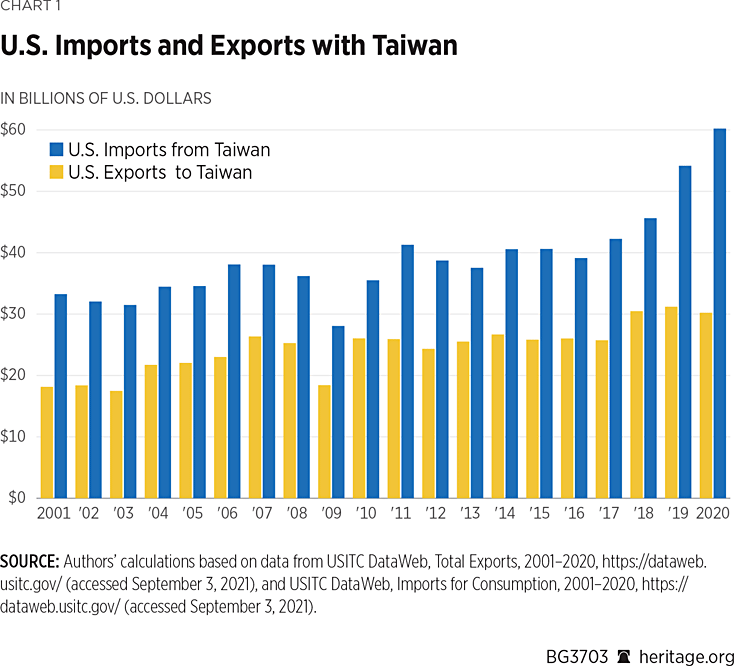
Taiwanese companies are also investing in the American economy. In 2001, foreign direct investment from Taiwan, as shown in Chart 2, was valued at $9.3 billion. In 2020, that value was $31.5 billion. TSMC, one of the largest semiconductor producers in the world, recently announced new investment in Arizona valued at roughly $12 billion. It is estimated that the first factory, which should be completed by 2024, would create 2,000 jobs. U.S. foreign direct investment in Taiwan increased by $22 billion over the same period. For example, Microsoft will spend $10 billion in Taiwan to build a data center by 2024, creating roughly 30,000 jobs there. These numbers represent not only increased trade between individuals in the two countries but also the growth and strength of America’s relationship with Taiwan.
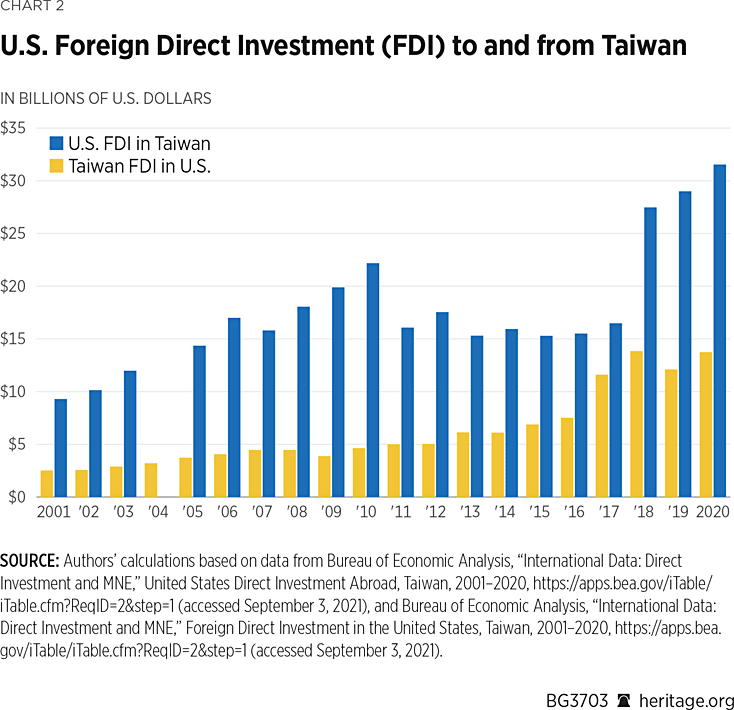
Estimated Effects of a U.S.–Taiwan Free Trade Agreement
Deepening America’s economic relationship with Taiwan should be a key priority of the Office of the U.S. Trade Representative. TIFA talks are a positive step, but these talks are limited to bilateral integration at the margins. To build on the growth in the existing trade relationship, securing a formal FTA should be a top priority. The purpose of this report is to inject new evidence supporting the economic case for such an FTA.
The 2002 ITC study used GTAP to eliminate tariffs. Our CGE model expands upon that work by also examining the effects of eliminating some non-tariff barriers to trade. The most recent Data Base from the GTAP is from 2014, where the average tariff paid by Americans to buy from abroad was roughly 3.4 percent. Taiwan’s average tariff rate in that year was about 6.9 percent. Without the tariffs imposed under the Trump Administration, the tariff elimination portion of an FTA with Taiwan would be relatively small. Despite low tariff rates, there are substantial non-tariff barriers in the United States and Taiwan that make it more expensive for individuals to trade.
Given the model’s base year, tariffs imposed in recent years under Section 232 of the Trade Expansion Act of 1962 and Sections 201 and 301 of the Trade Act of 1974 are not taken into account. However, Taiwan is subject to the tariffs imposed under Section 232 of the Trade Expansion Act and Section 201 of the Trade Act. Because of this, our model represents the estimated effects of an FTA with Taiwan under more normal circumstances, but it is likely a conservative estimate given the omission of these additional barriers. Any negotiations with Taiwan should include the removal of U.S. barriers under these laws as they result in a significantly higher U.S. average tariff rate.
Barriers Eliminated
Using the GTAP Data Base, we established 11 sectors: agriculture, rice, beef, pork, sugar, extraction, textiles and apparel, manufacturing, electrical devices, automotives, and services. The sectors were broken down in this way to allow for visibility of the effects of tariff and non-tariff barrier removal on specific sectors. In the model, we eliminate all tariff barriers between the United States and Taiwan. We also reduce or eliminate Taiwan’s non-tariff barriers on agriculture, beef, and pork imports as well as U.S. non-tariff barriers on agriculture, beef, pork, textiles and apparel, and automotive imports. Some non-tariff barriers were eliminated entirely—such as Taiwan’s import bans and licensing requirements for beef imports—because they are unrelated to science-based health and safety concerns. Other barriers, such as America’s import restrictions on poultry imports, were reduced by two-thirds to allow for the maintenance of minimum health and safety standards.
The quantitative analysis of non-tariff barriers in this model is not comprehensive. The model covers technical barriers to trade and sanitary and phytosanitary measures in the covered sectors but does not adjust for certain programs such as tariff-rate quotas. A more detailed explanation of the shocks applied in the model can be found in Appendix A.
Results
An FTA between the United States and Taiwan would have positive economic effects for both countries. Total trade would increase by $6.2 billion annually for the United States and by $3.8 billion annually for Taiwan. U.S. exports to Taiwan would increase in all sectors except rice, with the largest percent increases occurring in the beef (108.3 percent), pork (300.6 percent), sugar (107.8 percent), and automotive (119.3 percent) industries. Taiwan’s exports to the United States would increase in all sectors except services, with the largest percent increases occurring in the beef (102.5 percent), pork (179.0 percent), sugar (95.1 percent), and textiles and apparel (224.4 percent) industries. The increase in trade for both countries would also have a positive impact on economic growth. U.S. GDP would increase by a modest $246 million, and Taiwan’s GDP would increase by $641 million.REF An FTA with Taiwan would also likely impact trade with China. Under this model, U.S. exports to China would decrease in nearly all sectors, China’s total trade volume would decrease by just over $1 billion annually, and Chinese GDP would be negatively impacted.
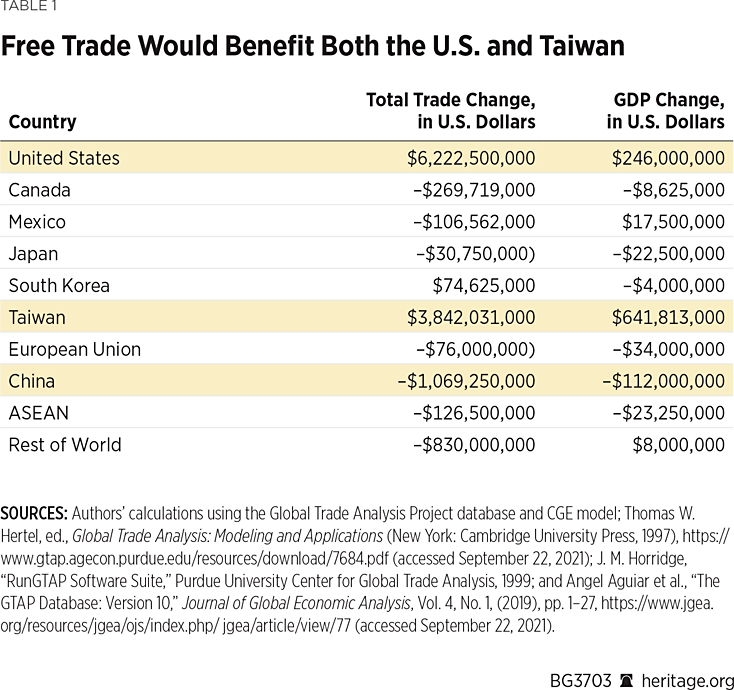
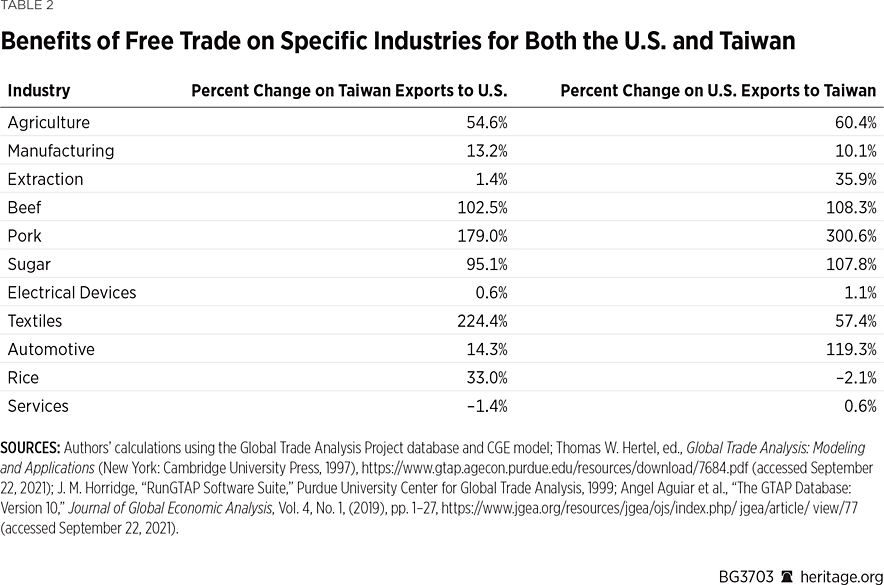
Conclusion
The United States and Taiwan have spent decades building a strong security and economic relationship. TIFA, Taiwan’s accession into the WTO, and other engagements aided in the deepening of economic relations. As shown in this model, a U.S.–Taiwan FTA would further deepen the partnership and lead to economic benefits for both countries. An FTA should cover all sectors and eliminate all non-tariff barriers that are not backed by science-based evidence for the protection of health and safety. Doing so would increase total trade, exports, and GDP for both countries while also providing market-based alternatives to trade with China.
Tori K. Smith was Jay Van Andel Senior Policy Analyst in Trade Policy in the Thomas A. Roe Institute for Economic Policy Studies at The Heritage Foundation. Gabriella Beaumont-Smith was Senior Policy Analyst in Macroeconomics in the Center for Data Analysis at The Heritage Foundation. Rachael Wolpert is Research Assistant in the Center for Energy, Climate, and Environment at The Heritage Foundation.
Appendix A: Methodology
CGE models are systems of equations that describe the incentives and behaviors of producers and consumers in an economy and the linkages between them. These linkages capture the combination of private household demand, government demand, and investor demand that is met by firms, which complete the flow of income and spending by buying inputs, hiring workers, and employing capital that is used in their production processes.REF
We use the GTAP Data Base to develop a 2014 database with 11 sectors, 10 regions, and three factors.REF The sectors created and chosen are based on the importance of reducing barriers within those sectors for an FTA between the United States and Taiwan: agriculture, manufacturing, extraction, beef, pork, sugar, electronics, textiles, automobiles, rice, and services. The regions are the United States, Canada, Mexico, Japan, the Republic of Korea, Taiwan, the European Union, China, the Association of Southeast Asian Nations, and an aggregated rest of world. The three factors are land, labor, and capital, which are mobile and in fixed supply.
In the CGE model, tariffs are removed in all sectors reciprocally between the United States and Taiwan.REF The shock of removing tariffs creates a disequilibrium that changes the global economy in the model. Tariff removal is expected to decrease consumer prices and increase consumer demand for imports, decrease the import prices and in turn increase goods imports, increase domestic production to meet the increase in consumer demand (which could increase exports), and increase GDP. The new values, which are the changes from the base rate (2014), represent the new equilibrium, where quantities of supply and demand are again equal at a new set of prices. Given that this new equilibrium is a result of an FTA, the new equilibrium values inform analysis of trade creation and destruction.
However, it has been increasingly important to reduce non-tariff barriers in FTAs as the WTO has successfully lowered tariff rates globally. Thus, for a proposed U.S.–Taiwan FTA, non-tariff barriers are reduced based on complaints by each party. The United States issues a report each year to document significant foreign barriers to U.S. exports, investment, and electronic commerce.REF We used this report to inform which non-tariff barriers Taiwan imposes on the United States that could be reduced or eliminated. Due to data limitations, we chose to reduce or eliminate only sanitary and phytosanitary (SPS) measures and technical barriers to trade (TBTs). We then matched these barriers to the Harmonized System (HS) sections. For example, import bans on beef matched Section 1 of the HS.
The data for ad-valorem estimates (AVEs) is still developing. We utilized the World Bank’s database for the U.S. AVEs.REF The World Bank divides non-tariff measure (NTM) AVEs into “technical” and “non-technical” barriers; we utilized only the “technical” AVEs to cover only SPSs and TBTs. We matched each AVE to the HS and then averaged the AVEs for each chapter to get an estimate for each HS section. For the United States, we shocked GTAP sectors, agriculture, beef, pork, textiles, and autos, which corresponded to HS sections 1 (animals), 2 (vegetables), 11 (textiles), and 17 (vehicles).
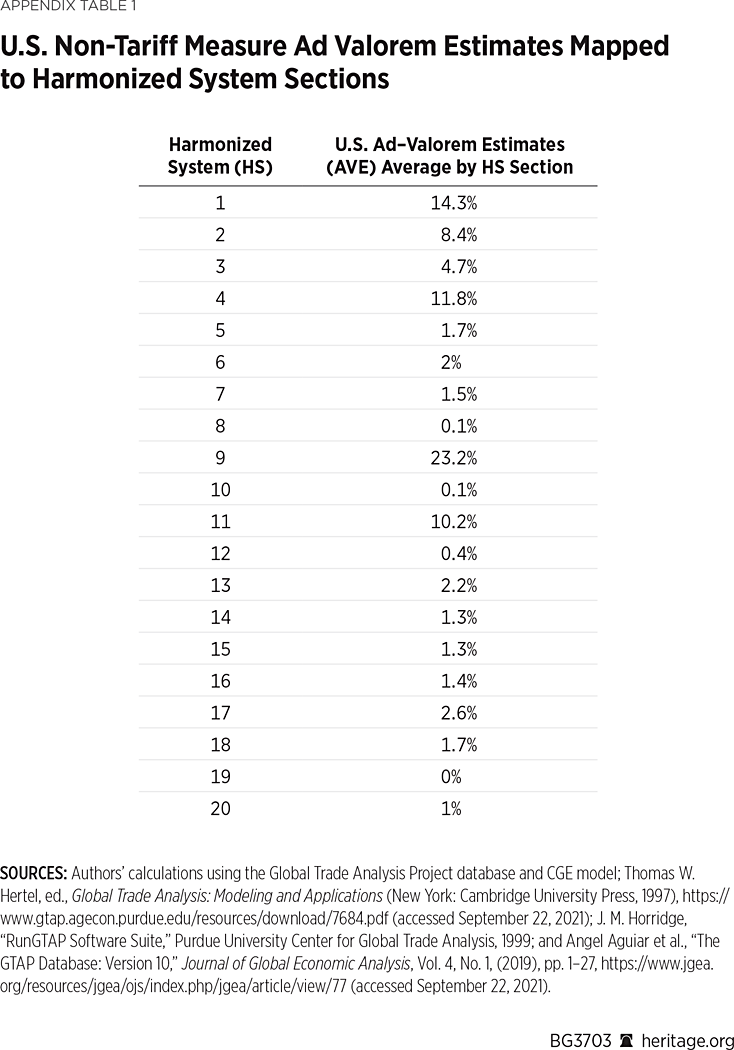
For Taiwan’s AVEs, we utilized Cadot et al. (2015) estimates for Asia as proxies for Taiwan. We use the values for SPS and TBTs only for HS Sections 1 (animals) and 2 (vegetables), because we only shocked the GTAP sectors of agriculture, beef, and pork for Taiwanese imports.REF Since Cadot et al. separates SPS and TBT AVEs, we summed the results of the shock values (calculations explained below) to apply to each sector.
Using Walmsley and Strutt (2021), we shock the ams variable, which is the share of imports received, accounting for the iceberg effect—which assumes that some value of the imports melt away during transit—so the amount that leaves the exporting country is higher than the amount that arrives at the importing country.REF In order to calculate how much to shock ams by, we used the following formula:
$$= \mathrm{[(1/(1+{final\ AVE\ NTM\over 100}) - (1/(1+{initial\ AVE\ NTM\over 100})] \over [(1/(1+{initial\ AVE\ NTM\over 100})]}$$
The CGE model is static, which does not provide insight into the economy’s dynamic adjustment process. Static models show the before and after of an economy when a shock is imposed. For example, in our experiment, the tariff removal and NTM changes are shocks that cause the reallocation of productive resources in more efficient ways. Another limitation of this model is the limited data for AVEs, and future research should consider different closure methods. For further analysis, welfare and terms of trade should be analyzed but were not within the scope of this paper.
Appendix B: Analysis and Interpretation of Some Results Through the Lens of the AMS Mechanism
As a result of using the ams variable, two effects on trade within the Armington structure can be observed: an expansion effect and a substitution effect.REF These effects work in opposite directions. The expansion effect is a productivity shock that applies only to importer businesses; consumers importing affected goods reduce their consumption with exporters in foreign markets but do not consume a lower amount of imports.REF The explanation for this is that as a result of the decreased NTMs, iceberg costs are also reduced; thus there is less potential for spoilage, theft, or loss in shipment. The substitution effect lowers the price of imports, causing a substitution to the imports. Basically, the firm will observe the equivalent of a technological change as a result of the NTM reduction, increasing productivity and reducing production costs, resulting in an increase in the quantity of goods imported. Thus, the U.S. increase in imports from Taiwan exists mostly in the sectors where both tariffs and NTMs were reduced or eliminated (highlighted in the chart below), which is expected and consistent with theory. However, sugar also saw a large increase in U.S. imports from Taiwan, which is likely a result of the tariff removal, as Taiwan imposed a tariff rate of around 15 percent. U.S. exports to Taiwan also increased the most in the sectors we reduced for Taiwan’s ams (also highlighted).
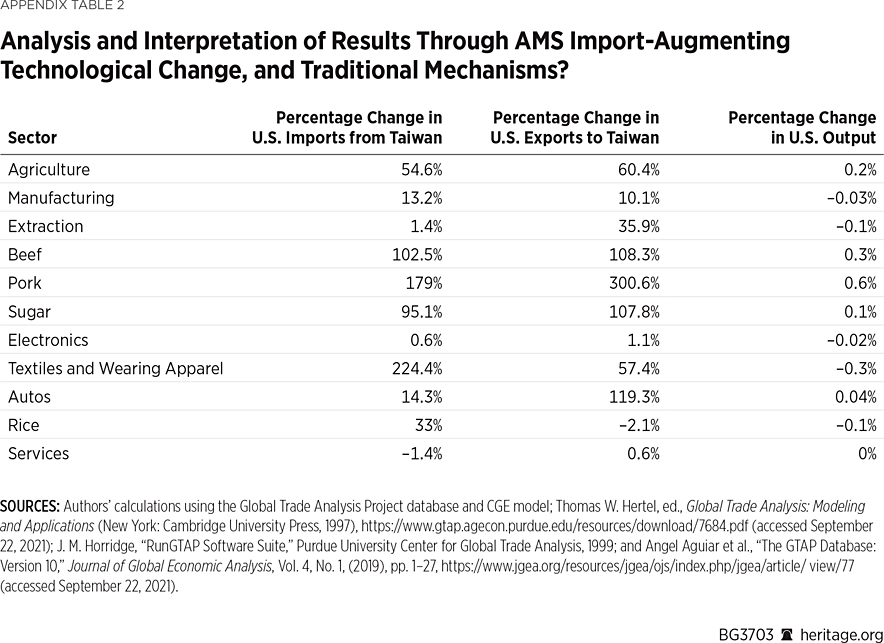
The productivity increase as a result of NTM reduction may not reconcile with the impact on GDP. For example, while imports, exports, and output for the United States increase, the GDP increase is very small—just 0.001 percent, or $246 million.REF Generally, under the ams method, the importer gains the most as a result of the productivity shock because the productivity gains mean that goods can be imported more cheaply or efficiently and other resources are allocated to more productive uses (the substitution effect). It would be appropriate to analyze this research question by assuming that the NTM is applied evenly between the importer and exporter, requiring both the ams and axs mechanisms, particularly considering how small are the U.S. real GDP gains.REF However, these gains may also be small as a result of the lower AVEs for U.S. NTMs, thereby creating a lower reduction in NTMs than in Taiwan.
It should also be noted that this FTA results in preferential treatment by removing tariffs and lowering NTMs between the United States and Taiwan. Therefore, the greatest changes for trade creation exist for these two parties. This is most clearly observed in the change in exports. U.S. pork exports to Taiwan increase by over 300 percent as a result of tariff removal and NTM reduction, while U.S. pork exports to all other regions fall by an average 0.29 percent. Thus, while there is huge trade creation between the United States and Taiwan, there is a small amount of trade diversion with all the other parties outside the FTA.


